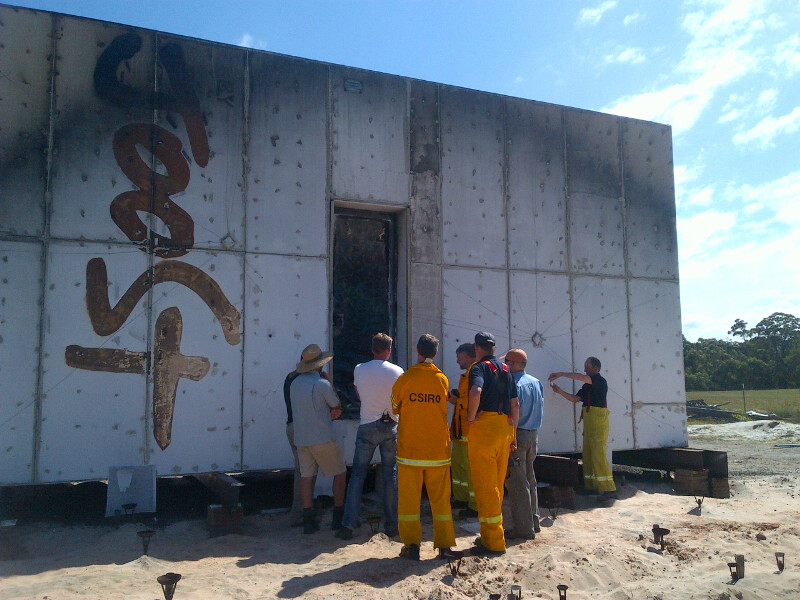Update 1/3/12 – Justin Leonard, the CSIRO scientist involved with the burn, has answered some questions in the comments section.
In the fight between straw and fire, what do you think would come out on top? Yesterday our fire scientists found out when they tried to burn down a house made of straw.
They took an eco-friendly house with ModakBoard cladding, a steel frame and walls insulated with straw and exposed it to a worst case bushfire scenario. Did it survive? Results say, yes it did.
The house, created by sustainable designer Joost Bakker, may provide an environmentally friendly building option for bushfire-prone areas.
The affectionately named “straw house” was blasted with a range of real life bushfire conditions, from a radiation build up phase to full flame immersion and then a radiation decay phase.
So how did it fair? The external temperature reached a scorching 1000oC while inside the house was a cool 35oC. There was minimal damage to the straw house’s cladding and while the steel frame heated up to 100–110oC it remained structurally sound and intact. Attached to the house was a about 70–odd sensors that measured what was happening inside and outside the building, so there are plenty more results to be analysed. For now, we know that when exposed to extreme bushfire conditions the little house that could, stood.
Big thanks go out to the New South Wales Rural Fire Service. They let us use the Eurobodalla Rural Fire Service Training Facility near Mogo – the only facility in Australia with a bushfire flame front simulator (pretty much a giant barbeque) that can test entire buildings under realistic bushfire conditions. Plus they were the only guys who could have put out the fire if the house did go up in flames.


5th October 2012 at 4:05 pm
This is very inspiring, and great to see that someone is coming up with solutions for a problem that is only going to get worse with climate change. Well done, it’s obviously early days but great to see someone’s onto it in a left of field way. My Dad designed an underground house in the 70’s with a grass roof, he was a hobby engineer, and a bit of a visionary…
23rd May 2012 at 12:54 pm
Hi Justin – would the CSIRO be prepared/have the necessary funding to work with say the producers of Modak board to design houses that are more likely to survive bushfire? If so, and subject to some standard cautions around householders oberving certain rules about plantings and debris around dwellings, I can only imagine the benefits to the community both in terms of safety and to the environment.
5th October 2012 at 11:10 am
HI Peter,
I think the industry – in particular Modak would be the financial benefactors of this work and should offer the funding should they want to go down this path.
14th May 2012 at 8:32 am
Is the Modak suitable for use in a flame zone area?
23rd May 2012 at 2:06 pm
the test we performed on this house was a worst case flame zone exposure, so yes it is likely to result in an approved design specification for flame zone construction.
9th March 2012 at 7:02 pm
very Impressive – well insulated houses are the way to go . What is the cost per square metre compared to a normal brick house ?
27th February 2012 at 2:17 pm
I agree with David. I have a straw bale house in a bushfire prone area and I assume ignition may occur where embers fly under the roof to ignite wooden beams and ceiling. I know tests in America have shown that compacted straw may smoulder but doesnt tend to ignite as there is less air present in the wallsthan in for instance a double brick or brick clad house. Obviously I would like to see a test carried out on a solid- straw built construction,and whether or not the old theory that whitewash(lime render) actually is a flame retardent?
1st March 2012 at 10:09 am
Hi Jane,
there are various fire tests results for rendered straw ball constructions which demonstrated what you have described, that the compacted strap slow smoulders because the straw compaction and the the render limits how much oxygen can get to the straw inside.
The building approach in this experiment uses full bound bailed that fit fairly tightly in the wall cavity. The only air access is via the vents unless the cladding is damaged. So I would expect them to smoulder at a greater rate than undamaged rendered bails but nothing like a free burning hay stack.
The roof of this house has an interesting design in which wall cladding reaches up to an earth covered roof, where there no access for embers to find there way into the underlying roof beams or details, and in this case they are steel trusses.
And yes agree with you on wanting to test solid straw constructions, the lab testing I have seen is very encouraging so it would great to see a whole house design put to the test so that design details like ember access to roof beams can be solved and proven